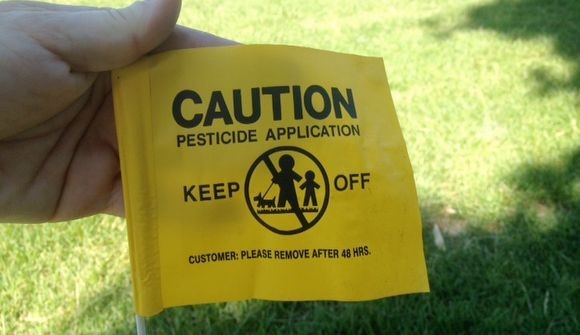By Dr. Lynn Wilder
If you or a lawn treatment service routinely treats your yard for weeds, pests or with fertilizer, do you know what chemicals are being applied and why? Take a minute to look at the ingredient label on the product’s container. Can you tell if it is safe for you or the environment?
| The word “pesticide” includes herbicides, disinfectants, fungicides, insecticides, natural and biological pesticides, rodenticides and other types of pesticides. |
If you use landscape products labeled “natural” and “organic,” does either word mean they are safe? They certainly can’t be safe for the target insect or weed. Otherwise, we’d ask for our money back!
Chrysanthemums are certainly organic and natural. The flowerheads contain pyrethins, which is an effective insecticide. Pyrethroids are synthetic (man-made) compounds that mimic pyrethins. Pyrethins are natural organic chemicals; phyrethroids are man made organic chemicals. Are they that different? Are they safe? Read the product label!
When signs are posted on someone’s yard alerting people to stay off, there is some level of toxicity associated with the product. Even if it’s not harmful to us, pets are very sensitive to certain compounds, and some compounds are toxic to fish and marine life. Pesticides and other products can harm beneficial insects that naturally control weeds and unwanted insects. Products may also harm pollinators.

If you use an organic fertilizer, a quick on-line search for organic lawn care services shows this description of a fertilizer one uses on lawns: “Organic fertilizer with a minimum of 30% nutrients from organic and natural sources, with the other nutrients coming from synthetic sources.” Is this enough to determine if the product is safe for you, your children, and your pets?
What does this blog have to do with our river and bay?
Excess rain or irrigation water runs off landscapes and may enter storm drains. Products applied to treat pests and feed lawns are part of that runoff. Storm drains empty into rivers and bays.
Pesticides can kill aquatic species and harm the ecosystem. Fertilizers and nutrients promote excess algal growth and deplete oxygen for plants and fish. We know this type of pollution supports and worsens harmful algal blooms–an increasing problem along our coastlines and lakes–which is deadly to many species of salt- and freshwater life.
| Pesticide-polluted stormwater can kill or harm plants, fish and wildlife, and may disrupt the entire food chain. The contamination may degrade the quality of surface and groundwater. |

Now that you know, does your lawn really need pesticides and fertilizer broadcast over the entire yard multiple times a year?
What can we do to minimize damage to the environment while maintaining our landscape?
- Consider replacing some or all of the lawn grass with native plants, grasses and flower species.
- Use compost. Composting creates an organic, slow-release fertilizer and improves the soil.
- Test the soil for nutrient deficiencies before using lawn chemicals.
- Read labels carefully and always apply lawn care products sparingly, and follow the safety recommendations.
- Allow proper drying time for liquid chemicals
- Never use lawn chemicals before a heavy rainfall is expected.
- Use caution on slopes and lawn edges to avoid fertilizer runoff into nearby storm sewers or waterways.
- Contact your county extension service for more information on lawn chemical use.
| A natural lawn reduces or eliminates the need for lawn chemicals. |
To learn more: Florida Friendly Landscaping (IFAS)
Florida Friendly Interactive Yard (FloridaYards.org)
Landscaping Your Yard and Fertilizing Responsibly (St. Johns Riverkeeper)
National Pesticide Information Center
Lynn Wilder is an Apalachicola resident, a longtime ARK member, and a recently-appointed board member.
View other ARK blogs here

